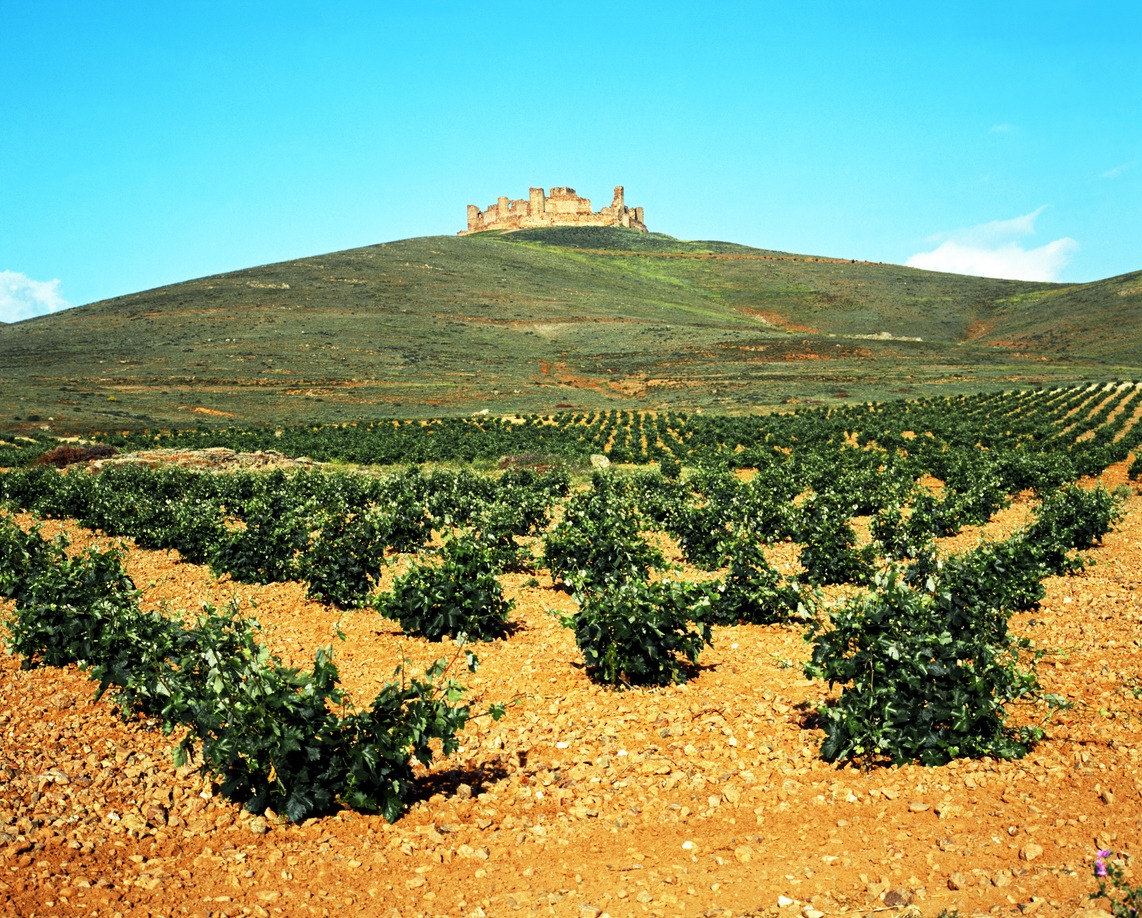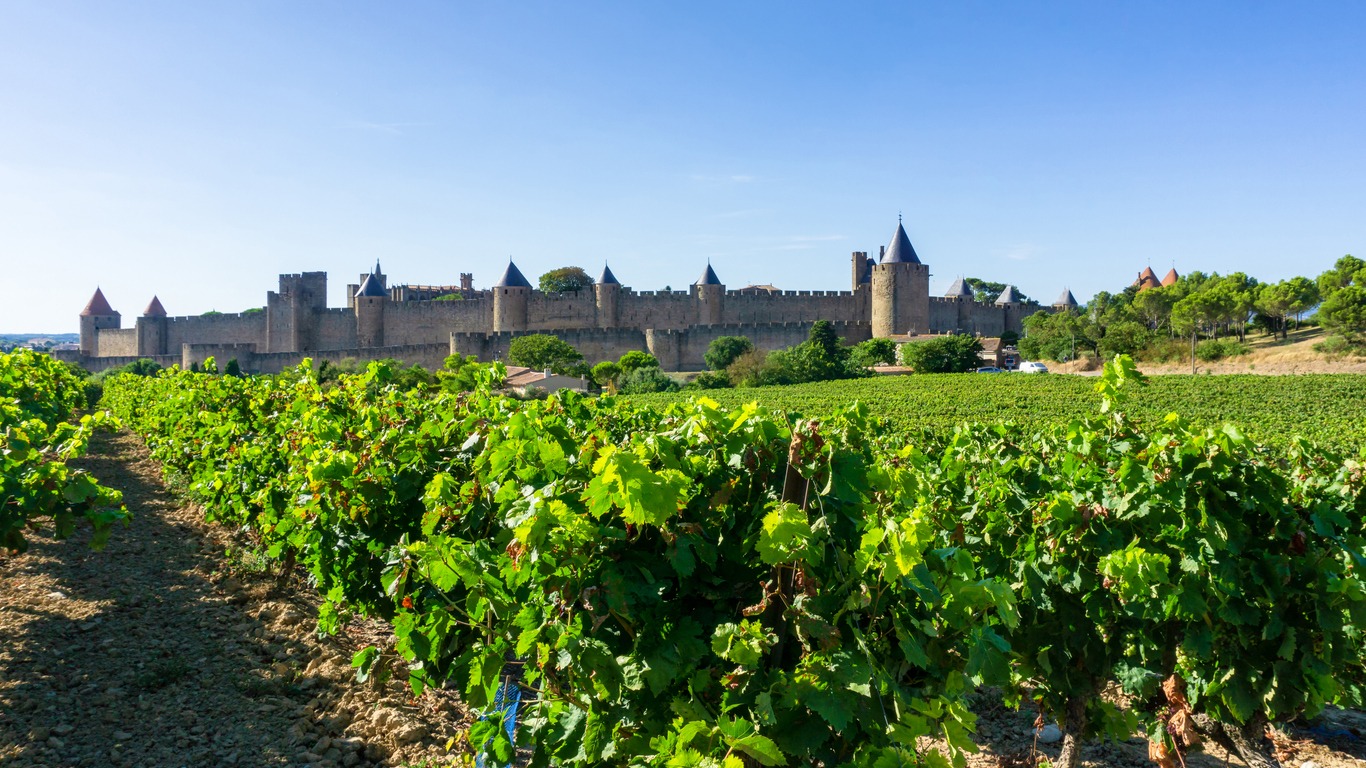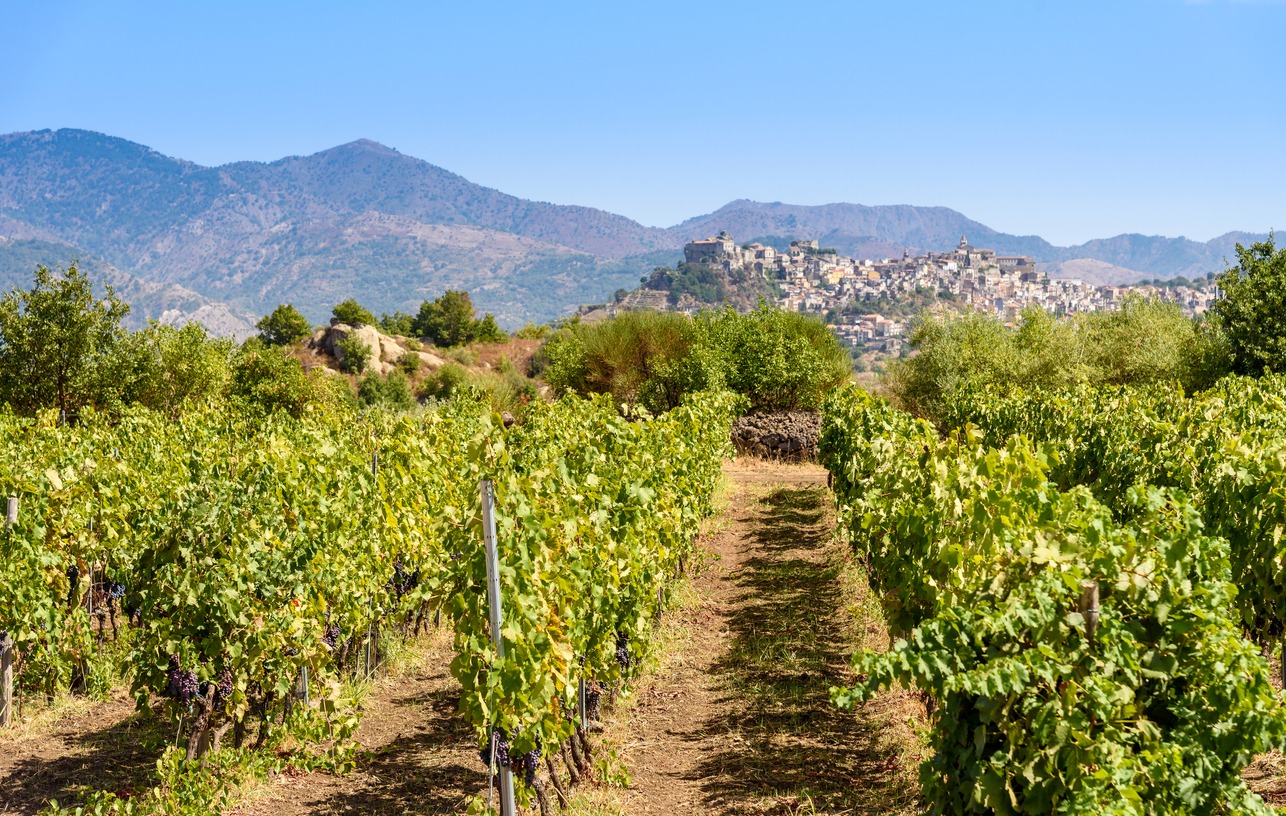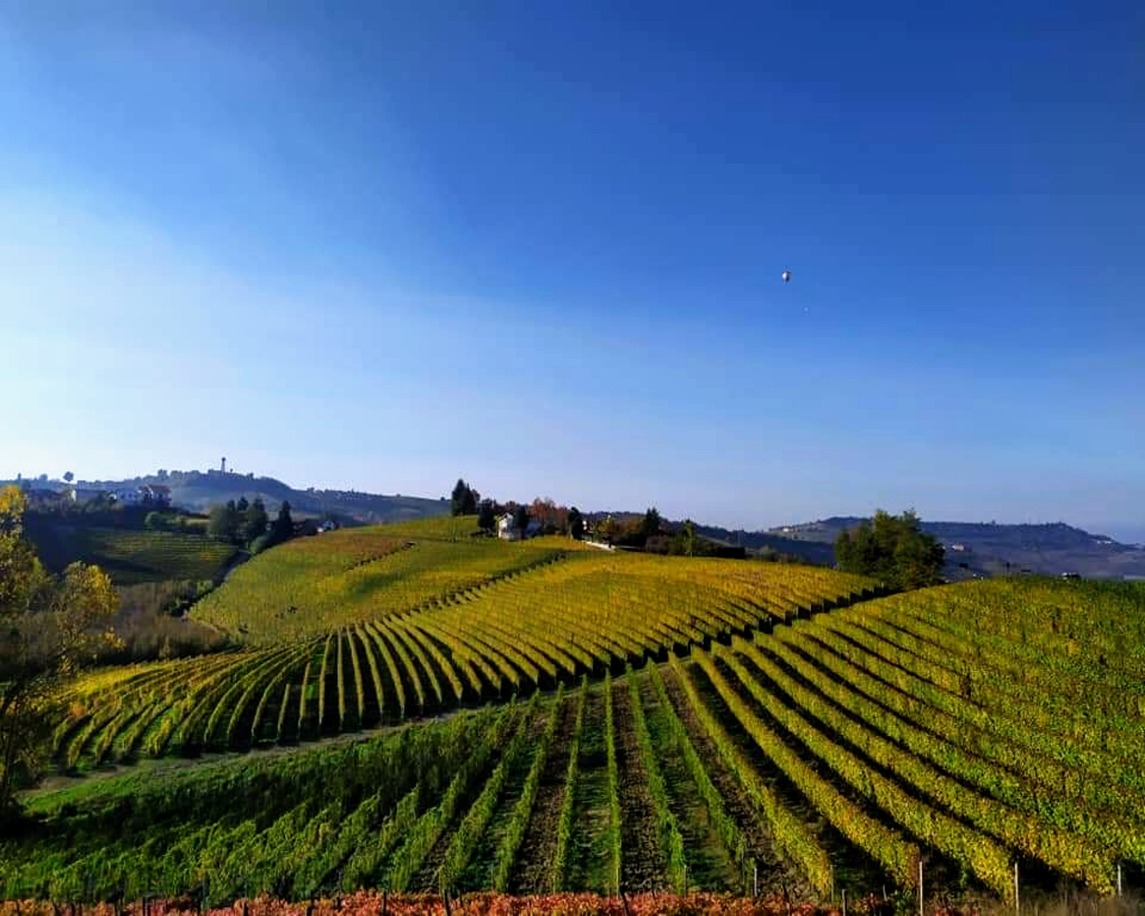La Mancha, Spain
This historic landscape is considered one of the top candidates for the largest wine region, with around 450,000 hectares of vineyards. The DO (Denominación de Origen) area of La Mancha within this region accounts for about 200,000 hectares.
- Geographical Location: La Mancha is centrally located in Spain, sprawling across the provinces of Cuenca, Ciudad Real, Toledo, and Albacete. This vast plateau is south of Madrid and is part of the larger Castilla-La Mancha autonomous community.
- Size and Scale: Covering around 450,000 hectares, it’s one of the largest contiguous vineyard areas globally. The sheer size allows for a significant diversity of wine styles and grape varieties.
- Climate and Terrain: The region is characterized by a continental climate, featuring long, hot summers and cold winters. This climate, combined with the high altitude (around 600 to 1,000 meters above sea level), contributes to significant temperature variations between day and night, which is beneficial for the accumulation of aromas and flavors in the grapes. The terrain is predominantly flat and consists of a limestone-based soil with a high lime content, which is conducive to viticulture.
- Grape Varieties: While La Mancha is traditionally known for its white wine production, primarily from the Airen grape, it has diversified significantly. Other white varieties include Macabeo and Chardonnay. For red wines, Tempranillo (locally known as Cencibel), Garnacha, Cabernet Sauvignon, and Merlot are prominent.
- Wine Production: The region is noted for its versatile wine production, including young, fresh wines and aged reds. It also produces rosés, sparkling wines (Cava), and some sweet wines. The modernization of winemaking techniques and a focus on quality have led to an increase in the reputation and variety of La Mancha wines.
- Appellation System: La Mancha wines are protected under the DO (Denominación de Origen) La Mancha, which ensures quality and authenticity. The DO status also means that wines adhere to specific production standards and are made from grapes grown in this region.
- Cultural Significance: Wine production in La Mancha is deeply entwined with Spanish culture and history. The region’s winemaking tradition dates back to Roman times and has been influenced by various cultures over the centuries, including the Moors and Christians. The wines of La Mancha are often associated with the imagery of Don Quixote, the iconic character from Miguel de Cervantes’ famous novel, which is set in this region.
- Tourism and Gastronomy: La Mancha is also a destination for wine tourism, offering visitors the chance to explore ancient bodegas, modern wineries, and picturesque vineyards. The region’s cuisine, which pairs excellently with its wines, includes Manchego cheese, game meats, and hearty stews.
The evolution of La Mancha from a bulk wine producer to a region known for quality and variety reflects the dynamic nature of the global wine industry. Its ability to adapt to modern winemaking while retaining its unique cultural heritage makes La Mancha a key player in the world of wine.
Midi, France
This region is similarly extensive, covering over 400,000 hectares of vineyards. It consists of several wine-growing regions, with Languedoc-Roussillon being the largest among them, covering 224,000 hectares.
- Geographical Location: The Midi region is located in the southern part of France, stretching from the Spanish border to the Rhône Valley. It includes the vast Languedoc-Roussillon area and other smaller regions. You can know more about the said region by reading our article, Reasons Why Languedoc is an Ideal Region for Winemaking.
- Size and Landscape: The Midi region covers over 400,000 hectares, making it one of the largest wine-producing areas in the world. The landscape is diverse, ranging from coastal plains to hilly terrains, which significantly influences the microclimates and terroirs within the region.
- Climate: The region enjoys a Mediterranean climate characterized by hot, dry summers and mild, wet winters. This climate is conducive to grape growing, as it reduces the risk of fungal diseases and allows grapes to ripen fully.
- Grape Varieties and Wine Production: The Midi is known for a wide variety of grape types. Red grape varieties include Grenache, Syrah, Mourvèdre, Carignan, and Cinsault. White varieties include Grenache Blanc, Picpoul, Roussanne, Marsanne, and Viognier. The region produces a broad spectrum of wine styles, from rich, full-bodied reds to fresh and aromatic whites, as well as rosés, sparkling wines, and even some sweet wines.
- Appellation System: The wines of the Midi are classified under several appellations, including AOC (Appellation d’Origine Contrôlée) and IGP (Indication Géographique Protégée). These designations ensure the quality and geographical authenticity of the wines.
- Wine Industry Evolution: Historically, the Midi was known for producing large quantities of inexpensive table wines. However, in recent decades, there has been a significant shift towards quality. Many producers are now focusing on lower yields, better vineyard practices, and modern winemaking techniques, which has led to an improvement in the quality of wines and increased international recognition.
- Cultural and Historical Significance: The wine history of the Midi dates back to ancient times, with the Greeks and later the Romans cultivating vines in the region. The wine culture is deeply embedded in the local lifestyle and traditions.
- Tourism and Gastronomy: The Midi region, with its picturesque vineyards, historic towns, and Mediterranean coastline, is a popular destination for wine tourism. The local cuisine, featuring fresh seafood, olives, herbs, and a variety of cheeses, pairs wonderfully with the regional wines.
Sicily, Italy
Sicily is the largest wine-growing region in Italy, with over 110,000 hectares dedicated to vineyards.
- Geographical Location: Sicily is the largest island in the Mediterranean Sea, located to the south of the Italian mainland. The wine region encompasses the entire island, with vineyards stretching from the coastal areas to the interior hills and mountains.
- Size and Terrain: Sicily boasts over 110,000 hectares of vineyards, making it one of the most extensive wine regions in Italy. The island’s diverse landscape includes coastal lowlands, rolling hills, and volcanic terrains, particularly around Mount Etna, contributing to a wide range of microclimates and soil types.
- Climate: The region enjoys a predominantly Mediterranean climate with hot, dry summers and mild winters. The varying altitudes and proximity to the sea also create microclimates that are ideal for different grape varieties.
- Grape Varieties and Wine Production: Sicily is home to several indigenous grape varieties, with Nero d’Avola being the most notable for red wines, and Grillo and Catarratto for white wines. The island also cultivates international varieties such as Chardonnay and Syrah. Sicilian wines range from robust and full-bodied reds to aromatic and fresh whites. The region is also famous for its sweet dessert wines, such as Marsala and Moscato di Pantelleria.
- Viticulture and Winemaking: Sicilian winemaking has undergone a significant transformation in recent decades, with a shift towards quality and the exploration of native varieties. Winemakers are increasingly focusing on sustainable practices and the expression of terroir in their wines.
- Appellation System: Sicilian wines are protected under various DOC (Denominazione di Origine Controllata) and IGT (Indicazione Geografica Tipica) classifications, ensuring quality and regional authenticity.
- Historical and Cultural Significance: Sicily’s wine history is ancient, with origins tracing back to the Greeks and Romans. Wine is deeply integrated into Sicilian culture, reflecting the island’s rich historical tapestry and diverse influences.
- Tourism and Gastronomy: The island is a popular destination for wine tourism, offering a blend of beautiful landscapes, historical sites, and culinary delights. Sicilian cuisine, with its emphasis on fresh, locally sourced ingredients, complements the diverse range of wines produced on the island.
Sicily’s dynamic wine industry, characterized by its ancient traditions and innovative approaches, has placed it firmly on the map as a region of high-quality and distinctive wines. The focus on indigenous grape varieties and unique terroirs continues to elevate Sicily’s reputation in the global wine community.
Bordeaux, France
The Bordeaux region, known for its high-quality wines, spans approximately 113,000 hectares, divided into 65 appellations.
- Geographical Location: Bordeaux is situated in southwest France, near the Atlantic coast. The region is divided by the Gironde Estuary and its tributaries, the Garonne and Dordogne rivers, creating distinct sub-regions with varying terroirs.
- Size and Terrain: Covering around 113,000 hectares, Bordeaux is a vast wine region. The area includes a range of landscapes, from gravelly soils along the left bank of the Gironde, conducive to growing Cabernet Sauvignon, to the clay and limestone soils of the right bank, favorable for Merlot and Cabernet Franc.
- Climate: Bordeaux has a maritime climate influenced by the Atlantic Ocean, leading to mild temperatures and moderate rainfall. This climate can vary across the region, affecting the style and character of the wines.
- Grape Varieties and Wine Styles: The region is best known for its red Bordeaux blends, primarily using Cabernet Sauvignon, Merlot, and Cabernet Franc. White Bordeaux wines are also produced, mainly from Sauvignon Blanc and Sémillon, ranging from dry to sweet, such as the world-famous Sauternes. The region also produces rosé, clairet, and sparkling wines (Crémant de Bordeaux).
- Appellation System: Bordeaux’s wines are governed by a complex classification system, with over 60 different appellations. The most famous classification is the 1855 Classification of Médoc, which ranked the châteaux of the Médoc region according to the quality of their wines.
- Viticulture and Winemaking: Bordeaux’s winemaking tradition dates back to Roman times. The region is known for its large, prestigious wine estates (châteaux) as well as smaller, family-owned vineyards. Modern Bordeaux has seen innovations in winemaking and vineyard management while maintaining a strong connection to traditional practices.
- Historical and Cultural Significance: Bordeaux has played a pivotal role in the history of winemaking. The region’s reputation and influence were further solidified by the British in the medieval period, who were significant consumers of Bordeaux wines.
- Tourism and Gastronomy: Bordeaux is a major destination for wine tourism, offering visits to famous châteaux, wine tastings, and wine education experiences. The region’s cuisine, known for its emphasis on local ingredients and classical French cooking techniques, pairs excellently with Bordeaux wines.
California, USA
California also boasts very large wine-growing areas, known as American Viticultural Areas (AVAs), contributing significantly to the wine production in the United States.
- Geographical Location: California’s wine regions extend along the state’s Pacific Coast and into its interior valleys, from the cooler coastal areas like Sonoma and Mendocino down to the warmer regions of Napa Valley and the Central Valley.
- Size and Diversity of Regions: California is vast in terms of wine production, encompassing numerous American Viticultural Areas (AVAs). Each AVA has its unique climate, soil, and topography, which contribute to the distinctive characteristics of the wines produced.
- Climate Variations: The state experiences a range of climatic conditions, from the cooler, fog-influenced regions along the coast to the hot and dry inland areas. This climatic diversity allows for the cultivation of a wide variety of grape types.
- Grape Varieties and Wine Styles: California is known for its Cabernet Sauvignon, Chardonnay, Pinot Noir, Merlot, Zinfandel, and Sauvignon Blanc, among others. The state produces an array of wine styles, from robust, full-bodied reds to elegant, nuanced whites, as well as sparkling wines and sweet dessert wines.
- Innovation in Winemaking: California is at the forefront of winemaking technology and sustainable practices. Many wineries employ innovative techniques in both vineyard management and winemaking processes, focusing on producing high-quality wines that reflect their terroir.
- Historical Context: The history of winemaking in California dates back to the 18th century with the Spanish missionaries. However, it was the Gold Rush of the 19th century that significantly boosted its wine industry. The modern era of California wine began in the mid-20th century and gained international acclaim after the 1976 Judgment of Paris, where California wines outperformed French wines in a blind taste test.
- Cultural Impact and Wine Tourism: California’s wine culture is vibrant and diverse, reflecting the state’s innovative spirit and commitment to quality. Wine tourism is a significant part of California’s economy, with visitors flocking to renowned regions like Napa and Sonoma for wine tastings, vineyard tours, and gourmet dining experiences.
- Global Influence: California is the largest wine producer in the United States and a significant player in the international wine market. Its wines are exported worldwide and are acclaimed for their quality and diversity.
The wine industry in California is a testament to the state’s ability to blend tradition with innovation, producing wines that are appreciated globally for their quality and distinctiveness. The state’s commitment to sustainability and cutting-edge winemaking techniques continues to set standards in the wine world.
These regions surely produce a lot of wine in a year. With this, have you ever thought about how many grapes they use in making bottles of wine? You may read our article, How Many Grapes Does It Take to Make a Single Bottle of Wine? to find out more about this.
Final Thoughts
These regions, with their distinct climates, soils, and grape varieties, not only contribute to the rich tapestry of global viticulture but also reflect the cultural heritage and evolving traditions of their respective areas. They remind us that wine is more than just a beverage; it’s a reflection of history, geography, and human endeavor. It’s also important to note that the size of the region doesn’t always correlate with the volume of wine produced, as factors like vineyard density, grape varieties, and winemaking practices can vary greatly between regions.
As climate and technology continue to evolve, these regions also demonstrate adaptability and innovation, ensuring that their wines remain relevant and revered in the changing landscape of global tastes and preferences. The commitment to sustainability and quality in these areas sets a standard for the rest of the wine world to follow.
In the end, the story of these wine regions is a testament to the enduring allure of wine. It’s a narrative of people, places, and passion coming together to create something that transcends time and borders, bringing joy and connection to those who appreciate the finer things in life. As we raise our glasses to these magnificent wine-producing regions, we celebrate not just the wine itself but the spirit and dedication that goes into every bottle. Here’s to the ongoing journey of discovery in the vast and wonderful world of wines!





